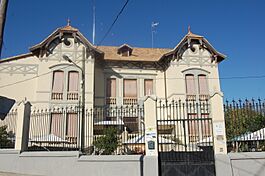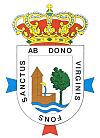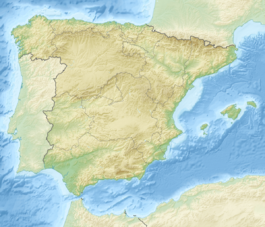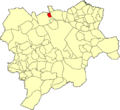Fuensanta, Albacete facts for kids
Quick facts for kids
Fuensanta
|
||
|---|---|---|

Villa Manolita
|
||
|
||
| Country | ||
| A. community | ||
| Province | ||
| Area | ||
| • Total | 23.96 km2 (9.25 sq mi) | |
| Population
(January 1, 2021)
|
||
| • Total | 284 | |
| • Density | 11.85/km2 (30.7/sq mi) | |
| Time zone | UTC+01:00 | |
| Postal code(s) |
02637
|
|
| MCN | 02032 | |
Fuensanta is a small town in Spain. It is located in the northern part of the province of Albacete. This province is part of the Castilla-La Mancha region. Fuensanta is also part of the La Mancha del Júcar-Centro area.
The town has about 284 people living there (as of 2021). It is about 36 kilometers (22 miles) away from the main city of the province. The total area of Fuensanta is about 23.96 square kilometers (9.25 square miles).
History of Fuensanta
The story of Fuensanta began in 1482. People believed that a holy virgin appeared here, and a spring of water started flowing. Because of this, a small chapel was built. At first, this chapel belonged to a nearby town called La Roda.
Later, around 1561, a group of monks called the Trinitaria Order bought the chapel. They wanted to build a monastery there. This caused a long disagreement with the church in La Roda.
Over time, people from nearby areas started visiting the holy spring to bathe. A small village grew around the spring. This village eventually became the town of Fuensanta. By 1579, about 20 people lived there.
In 1671, the population grew to 40 people. Fuensanta then became an independent town, separate from La Roda. They paid a large sum of money to the king for this freedom. La Roda tried to fight this decision, but in 1672, Fuensanta's independence was confirmed.
In the early 1800s, the government took over many church properties. The Trinitarios Monastery was left empty. Eventually, the town council took ownership of it. The monastery's church then became the local parish church, replacing the older one.
Important Buildings
Fuensanta has a main church, which used to be the old convent of the Trinitarios friars. Inside, people honor Our Lady of the Remedies of Fuensanta. Today, the building has two main parts: the church and the cloister.
The church part is a rectangular room with arched ceilings. A dome sits on top, decorated with plaster images of Trinitarios saints. The entrance room also has a dome with painted designs. The outside of the church is simple, built in a style called Baroque.
The cloister was built in the 1500s. It is a large square area with two levels of arched walkways. These arches are supported by columns that hold up the corridors above.
In the old gardens of the convent, there is a small chapel. This chapel is very important to the people because it marks the spot where the virgin was believed to have appeared at the spring.
Another old religious building in Fuensanta is the former San Gregorio Nacianceno church. It was built in the 1600s. Now, it is privately owned and used as a storage building.
There is also an 18th-century Baroque-style building in town. It was once one large house but is now divided into three. It is known for its fancy Rococo-style front and beautiful ironwork. You can also find a small palace called Villa Manolita. It's also known as the House of the Mannas. This building was rebuilt in 2003 and is now a rural guesthouse.
Local Celebrations
Fuensanta has several special days and celebrations throughout the year:
- May 9: This is the day of Saint Gregory of Nazianzus.
- The Saturday after San Gregorio: People celebrate the return of the Virgin of the Remedies to La Roda.
- Three weeks later: There is another celebration for the Virgin's return to Fuensanta.
- August 9 to 15: The town holds a Culture Week with various events.
- September 8: This is the Fair of the Virgin of the Remedies, a big local festival.
See also
 In Spanish: Fuensanta para niños
In Spanish: Fuensanta para niños
Images for kids





